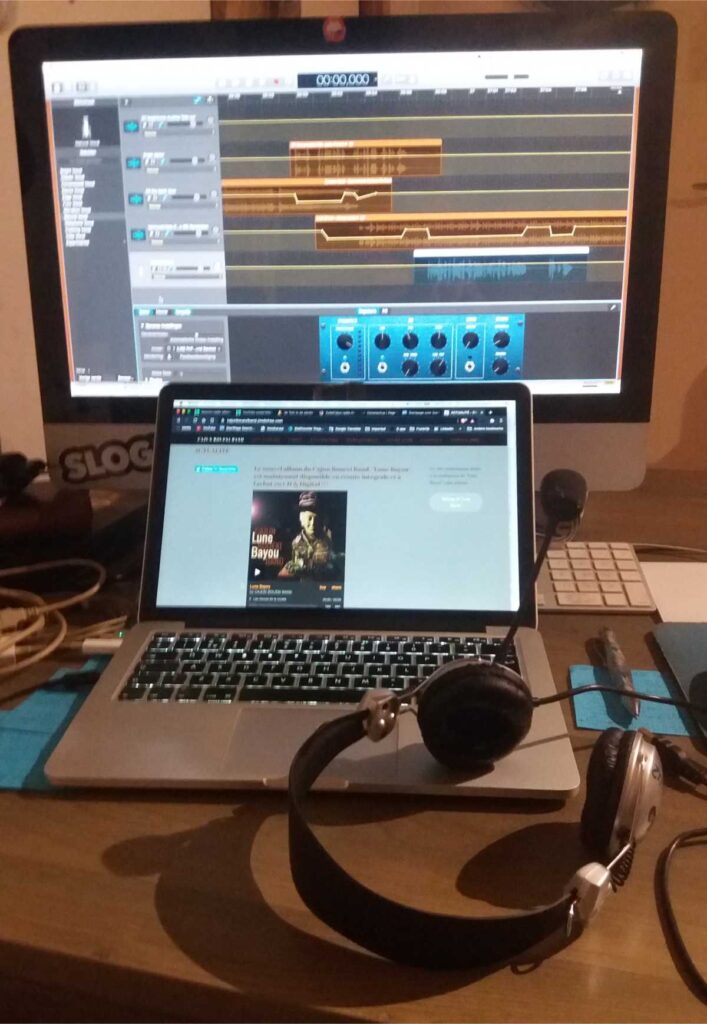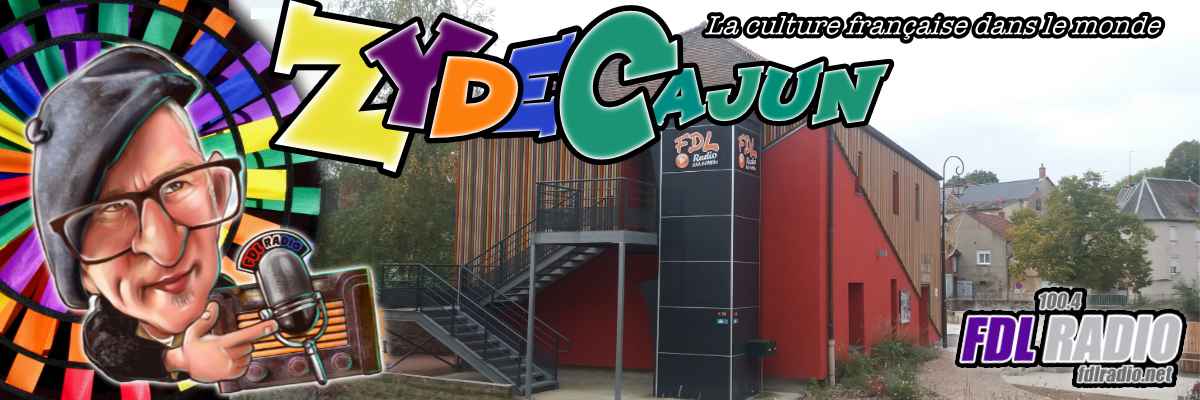Française | English | Nederlands

ZydeCajun Radio Home Studio adapté.
L’écran de votre ordinateur est toujours trop petit. Garageband occupe tout l’écran. Deux petites fenêtres, l’une pour les jingles et l’autre pour rechercher la musique. Ensuite, un simple éditeur de texte pour créer la liste de lecture et, bien sûr, Internet pour rechercher et lire les messages.
Tout cela se passait en fait sur l’écran gauche de 17 pouces et c’était très encombrant pour l’espace nécessaire, surtout si vous vouliez lire du texte et voir combien de temps vous pouviez parler avant qu’il y ait une pause dans la musique (souvent visible dans le fichier d’ondes de la chanson).
Maintenant c’est résolu et nous avons trois écrans et je peux vous dire que c’est beaucoup plus facile de travailler avec. Le mac air est au dessus de la table de mixage et ce n’est pas un problème. Il est installé correctement et nous n’avons pas besoin d’y toucher pendant l’émission.
ZydeCajun Radio Home Studio Adapted.
Your computer screen is always too small. Garageband actually takes up the entire screen. Two small windows, one for the jingles and the second to look up the music. Then a simple text editor to create the playlist and then, of course, intenet to search and read out messages.
That actually all happened on the left 17” screen and that was crowded for the space needed, especially if you wanted to read out text and also see how long you could talk before there was a pause in the music (often visible in the song’s wavefile.
Now that’s solved and we have three screens and I can tell you it’s a lot easier to work with. The mac air is on top of the mixer and that is not a problem. It’s set up properly and we don’t have to touch it during the program.
ZydeCajun Radio Thuisstudio aangepast.
Het scherm van je computer is altijd te klein. Garageband neemt eigenlijk het hele scherm in beslag. Twee kleine vensters, één voor de jingles en het tweede om de muziek op te zoeken. Dan een eenvoudige teksteditor om de afspeellijst te maken en dan natuurlijk intenet om te zoeken en berichten voor te lezen.
Dat gebeurde eigenlijk allemaal op het linker 17” scherm en daar was het druk voor de benodigde ruimte, vooral als je tekst wilt voorlezen en ook wilt kijken hoe lang je kunt praten voordat er een pauze in de muziek zit (vaak zichtbaar in de wavefile van het nummer.
Nu is dat opgelost en hebben we drie schermen en ik kan je vertellen dat het een stuk makkelijker werken is. De mac air staat bovenop de mixer en dat is geen probleem. Het is goed ingesteld en we hoeven het niet aan te raken tijdens het programma.

C’est la question que m’a posée Gary Hayman (États-Unis), un passionné de cajun et de zydeco.
La meilleure chose à propos de la radio est bien sûr de vivre dans un studio professionnel ou devant un public en direct, mais dans le processus vous serez de plus en plus gâté et plus exigeant. Je préfère travailler avec une console de mixage professionnelle où je peux démarrer les chansons et les jingle avec des boutons de démarrage rapide afin de pouvoir continuer à lire en même temps le texte à l’écran si je le souhaite. Un microphone avec un bon traitement est également un plus. La toute fin, c’est quand toutes les chansons ont des temps d’intro pour que je puisse voir combien de temps je peux parler avant que le chant ne commence et où je peux commencer mon jingle. Par exemple: intro 22 secondes jingle vocal (sans musique) 7 secondes puis je peux parler pendant 15 secondes et avec le jingle j’arrive exactement au chant. Et ainsi, en tant que deejay, vous devenez de plus en plus un perfectionniste, ce qui contribue à véhiculer une atmosphère dans votre programme.
À la maison, je fais cela sur mes ordinateurs Mac avec le programme GarageBand, je crée mes jingles, je modifie les éléments du programme et je crée mon programme complet. (voir capture d’écran) J’utilise deux pistes pour les jingles, les mini-programmes et les morceaux de musique de fond. Deux pistes pour les pistes musicales et une piste micro. Pour mon programme radio, je peux régler avec précision le volume par piste avec la souris et définir une transition entre deux ou plusieurs pistes. Avec la piste microphone, il existe de nombreuses options pour ajuster votre voix, comme un compresseur pour garantir que le texte parlé doux et fort n’est pas enregistré trop doux ou trop fort pour l’intelligibilité et la distorsion.
Avec une interview enregistrée, le fichier entier est édité dans Audacity pour égaliser les volumes des deux haut-parleurs et éventuellement définir un filtre pour un bourdonnement.
Pour enregistrer des chansons à partir de YouTube ou d’autres sources, j’utilise Audio Hijack. Je travaille avec deux ordinateurs pour pouvoir lire un texte sur l’autre écran, comme avec l’artiste en vedette. J’espère que tu aimes comment je fais tout ça?

Making FDL radio, at home on the computer, how do I do that?
That was the question I got from cajun & zydeco enthusiast Gary Hayman (U.S).
The best thing about making radio is of course live in a professional studio or in front of a live audience, but in the process you will be increasingly spoiled and more demanding. I prefer to work with a professional mixing console where I can start the songs and jingle’s with quick start buttons so that I can keep reading at the same time the text on the screen if I wish. A microphone with good processing is also a plus. The very end is when all songs have intro times so that I can see how much longer I can talk before the vocals start and where I can start my jingle. For example: intro 22 seconds vocal jingle (without music) 7 seconds then I can talk for 15 seconds and together with the jingle I arrive exactly at the vocals. And so as a deejay you become more and more a perfectionist, which contributes to conveying an atmosphere in your program.
At home I do that on my Mac computers with the GarageBand program, I make my jingles and edit program items and make my complete program. (see screenshot) I use two tracks for the jingles, mini program songs, and the background music songs. Two tracks for the music tracks and a microphone track. For my radio program I can precisely adjust the volume per track with the mouse and set a transition between two or more tracks. With the microphone track there are many options to adjust your voice such as a compressor to ensure that soft and loud spoken text is not recorded too soft or too loud for intelligibility and distortion.
With a recorded interview, the entire file is edited in Audacity to equalize the volumes of both speakers and possibly set a filter for a hum sound.
To record songs from YouTube or other sources I use Audio Hijack. I work with two computers so that I can read a text on the other screen, such as with the spotlight artist. I hope you like how I do all that?
FDL radio maken, thuis op de computer, hoe doe ik dat ?
Dat was de vraag die ik kreeg van cajun & zydeco enthousiast Gary Hayman (U.S).
Het leukste van radio maken is natuurlijk live in een professionele studio of voor een live publiek, maar al doende wordt je steeds meer verwend en veeleisender. Het liefst werk ik met een professionele mengtafel waar ik de computer de nummers en jingle’s kan met snelstart buttons kan starten zodat ik mijn ogen de tekst kan blijven lezen op het scherm indien ik dat wens. Een microfoon met goede processing is eveneens een pluspunt. Helemaal het einde is als alle nummers voorzien zijn van intro tijden zodat ik kan zien hoe lang ik nog kan praten voordat de zang begint en waar ik mijn jingle nog kan starten. Bijvoorbeeld: intro 22 seconden vocale jingle (zonder muziek) 7 seconde dan mag ik 15 seconde praten en samen met de jingle kom ik dan exact uit bij de zang. En zo wordt je als deejay steeds meer een perfectionist wat bijdraagt om een sfeer in je programma over te dragen.
Thuis doe ik dat op mijn Mac computer met het programma GarageBand, ik maak daar mijn jingle’s edit programma items en maak mijn complete programma. (zie scherm afbeelding)
Ik gebruik twee sporen voor de jingles, mini programma songs, en de achtergrond muziek nummers. Twee sporen voor de muziek nummers en een microfoon spoor.
Voor mijn radio programma kan ik per spoor met de muis exact het volume aanpassen en een overgang instellen tussen twee of meer tracks. Bij het microfoon spoor zijn er vele opties om je stem aan te passen zoals een compressor om ervoor te zorgen dat zachte en luid gesproken tekst niet te zacht of te hard opgenomen worden in verband met de verstaanbaarheid en vervorming.
Bij een opgenomen interview wordt het gehele bestand bewerkt in Audacity om de volumes van beide sprekers gelijk te trekken en eventueel een filter in te stellen voor een brom geluidje.
Om nummers op te nemen van YouTube of andere bronnen gebruik ik Audio Hijack.
Ik werk met twee computers zodat ik op het andere scherm een tekst kan oplezen zoals bijvoorbeeld met de spotlight artiest. Ik hoop dat je het leuk vindt hoe ik dat allemaal doe?
